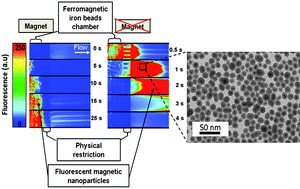Magnetic core shell nanoparticles (MCSNPs) 30 nm diameter with a magnetic weight of 10% are usually much too small to be trapped in microfluidic systems using classical external magnets. Here, a simple microchip for efficient MCSNPs trapping and release is presented. It comprises a bed of micrometric iron beads (6–8 μm diameter) packed in a microchannel against a physical restriction and presenting a low dead volume of 0.8 nL. These beads of high magnetic permeability are used to focus magnetic field lines from an external permanent magnet and generate local high magnetic gradients. The nanoparticles magnetic trap has been characterised both by numerical simulations and fluorescent MCSNPs imaging.
Numerical simulations have been performed to map both the magnetic flux density and the magnetic force, and showed that MCSNPs are preferentially trapped at the iron bead magnetic poles where the magnetic force is increased by 3 orders of magnitude. The trapping efficiency was experimentally determined using fluorescent MCSNPs for different flow rates, different iron beads and permanent magnet positions. At a flow rate of 100 μL h−1, the nanoparticles trapping/release can be achieved within 20 s with a preconcentration factor of 4000.

You have access to this article
 Please wait while we load your content...
Something went wrong. Try again?
Please wait while we load your content...
Something went wrong. Try again?


 Please wait while we load your content...
Please wait while we load your content...